SWISS SHOW ) MODELS By john Moon' j RAM NEW
Page 72
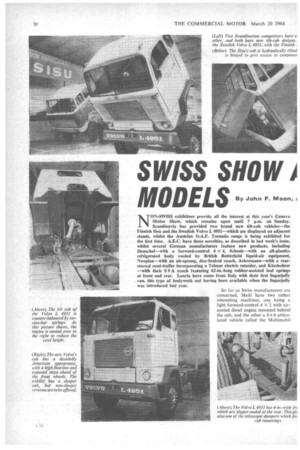
Page 73
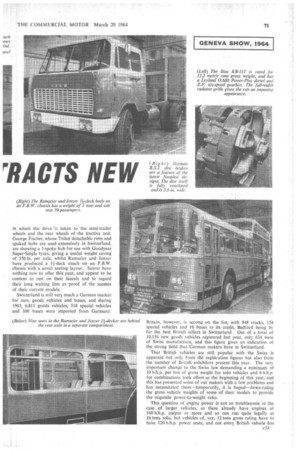
Page 74
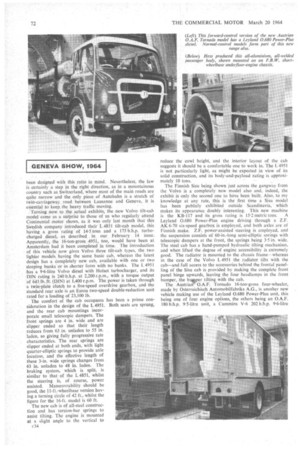
Page 75
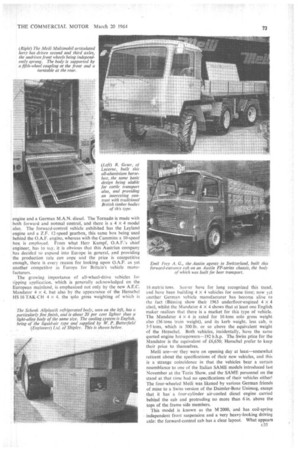
Page 76
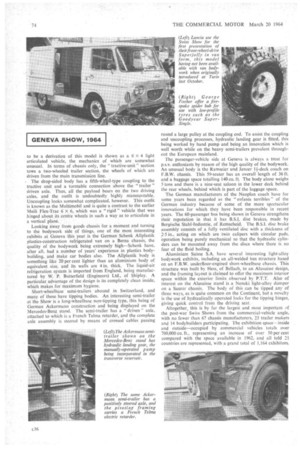
If you've noticed an error in this article please click here to report it so we can fix it.
NON-SWISS exhibitors provide all the interest at this year's Geneva Motor Show, which remains open until 7 p.m. on Sunday. Scandinavia has provided two brand new tilt-cab vehicles—the Finnish Sisu and the Swedish Volvo L 4951—which are displayed on adjacent stands, whilst the Austrian O.A.F. Tornado range is being exhibited for the• first time. A.E.C. have three novelties, as described in last week's issue, whilst several German manufacturers feature new products, including Henschel—with a forward-control 4 x. 4, Schenk—with an all-plastics refrigerated body cooled by British Butterfield liquid-air equipment, Neoplan—with an air-sprung, disc-braked coach, Ackermann—with a rearsteered semi-trailer incorporating a Telmar electric retarder, and Kiissbobrer —with their S 9 A coach featuring 62-in.-long rubber-assisted leaf springs at front and rear. Lancia have come from Italy with their first Superjolly van, this type of bodywork not having been available when the Superjolly was introduced last year..
So far as Swiss manufacturers are concerned, Meili have two rather interesting machines, one being a light forward-control 4 x 2 with aircooled diesel engine mounted behind the cab, and the other a 6x 4 articulated vehicle called the Multimobil
in which the drive is taken to the semi-trailer wheels and the rear wheels of the tractive unit. George Fischer, whose Trilex detachable rims and spoked hubs are used extensively in Switzerland, are showing a 5-spoke hub for use with Goodyear Super-Single tyres, giving a useful weight saving of 350 lb. per axle, whilst Ramseier und Jenzer have produced a fl-deck coach on an F.B.W. chassis with a novel seating layout. Saurer have nothing new to offer this year, and appear to be
content to rest on their laurels and to regard their long waiting lists as proof of the success of their current models.
Switzerland is still very much a German market for cars, goods vehicles and buses, and during 1963, 6,811 goods vehicles, 318 special vehicles and 106 buses were imported from Germany. Britain, however, is second on the list, with 948 trucks, 154 special vehicles and 16 buses to its credit, Bedford being by far the best British sellers in Switzerland. Out of a total of 10,156 new goods vehicles registered last year, only 634 were of Swiss manufacture, and this figure gives an indication of the strong hold that German makers have in Switzerland.
That British vehicles are still popular with the Swiss is apparent not only from the registration figures but also from the number of British exhibitors present this year. The very important change to the Swiss law demanding a minimum of 10 b.h.p. per ton of gross weight for solo vehicles and 6 b.h.p. for combinations took effect at the beginning of this year, and this has presented some of our makers with a few problems and has necessitated them—temporarily, it is hoped—down-rating the gross vehicle weights of some of their models to provide the requisite power-to-weight ratio.
This question of engine power is not so troublesome in the 'case of larger vehicles, as these already have engines of 160 b.h.p. output or more and so can run quite legally at 16 tons solo, but vehicles of, say, 12 tons gross rating have to haVe 120 b.h.p. power units, and not every British vehicle has
been designed with this ratio in mind. Nevertheless, the law is certainly a step in the right direction, as in a mountainous country such as Switzerland, where most of the main roads are quite narrow and the only piece of Autobahn is a stretch of twin-carriageway road between Lausanne and Geneva, it is essential to keep, thc heavy traffic moving. Turning now to the actual exhibits, the new Volvo tilt-cab model came as a surprise to those of us who regularly attend Continental motor shows, as it was only last month that this Swedish company introduced their L.4851 tilt-cab model, this having a gross rating of 14-5 tons and a 175 b.h.p. turbocharged diesel, as described in our February 14 issue. Apparently, the 16-ton-gross 4951, too, would have been at Amsterdam had it been completed in time. The introduction of this vehicle now gives Volvo three tilt-cab types, the two lighter models, having the same basic cab, whereas the latest design has •a completely new cab, available with one or two sleeping bunks or in shorter form with no bunks. The L 4951 has a 956-litre Volvo diesel with Holset turbocharger, and its DIN rating is 240 b.h.p. at 2,200 r.p.m., with a torque output of 643 lb. ft. (DIN) at 1,400 r.p.m. The power is taken through a twin-plate clutch to a five-speed overdrive gearbox, and the standard rear axle is an Eaton two-speed double-reduction unit rated for a loading of 23,100 lb.
The comfort of the cab occupants has been a prime consideration in the design of the L4951. Both seats are sprung, and the rear cab mountings incorporate small telescopic dampers. The front springs are 4 in. wide and are slipper ended so that their length reduces from 63 in. unladen to 55 in. laden, so giving fully progressive rate characteristics. The rear springs are slipper ended at both ends, with light quarter-elliptic springs to provide axle location, and the effective length of these 3-in, wide springs changes from 63 in. unladen to 48 in. laden. The braking system, which is split, is similar to that• of the L 4851, whilst the steering is, of course, power• assisted. Manceuvrability should be good, the 11-ft.-wheelbase version having a turning circle of 42 ft., whilst the figure for the 16-ft. model is 60 ft.
The new cab is of all-steel construction and has torsion-bar springs to assist tilting. The engine is mounted at a slight angle to the vertical to r34 reduce the cowl height, and the interior layout of the cab suggests it should be a comfortable one to work in. The L 4951 is not particularly light, as might be expected in view of its solid construction, and its body-and-payload rating is approximately 10 tons.
The Finnish Sisu being shown just across the gangway from the Volvo is a completely new model also and, indeed, the exhibit is only the second one to have been built. Also, to my knowledge at any rate, this is the first time a Sisu model has been publicly exhibited outside Scandinavia, which makes its appearance doubly interesting. This new machine
is the KB-117 and its gross rating is 1552 metric tons. A Leyland 0,680 Power-Plus engine driving through a Z.F. AK 6-70 six-speed gearbox is employed, and both axles are of Finnish make. Z.F. power-assisted steering is employed, and the suspension consists of 60-in.-long semi-elliptic snrings with telescopic dampers at the front, the springs being 3-5 in. wide. The steel cab has a hand-pumped hydraulic tilting mechanism, and when lifted the degree of engine accessibility is extremely good. The radiator is mounted to the chassis frame— whereas in the case of the Volvo L 4951 the radiator tilts with the cab—and full access to the accessories behind the frontal panelling of the Sisu cab is provided by making the complete front panel hinge upwards, leaving the four headlamps in the front bumper, the buiper tilting with the cab.
The Austriair 0.A.F. Tornado 16-ton-gross four-wheeler, made by Osterreichisch Automobilfabriks A.G., is another new vehicle making use of the Leyland 0.680 Power-Plus unit, this being one of four engine options, the others being an 0.A.F. 180 b.h.p. 9-5-litre unit, a Cummins V-6 202 b.h.p.
engine and a German M.A.N. diesel. The Tornado is made with both forward and normal control, and there is a 4 X 4 model also. The forward-control vehicle exhibited has the Leyland engine and a Z.F. 12-speed gearbox, this same box being used behind the O.A.F. engine, whereas with the Cummins a 10-speed box is employed. From what Herr Kumpf, 0.A.F.'s chief engineer, has to say, it is obvious that this Austrian company has decided to expand into Europe in general, and providing the production rate can cope and the price is competitive enough, there is every reason for looking upon 0.A.F. as yet another competitor in Europe for Britain's vehicle manufacturers.
The growing importance of all-wheel-drive vehicles for tipping application, which is generally acknowledged on the European mainland, is emphasized not only by the new A.E.C. Mandator 4 x 4, but also by the appearance of the Henschel HS 16 TAK-CH 4 x 4, the solo gross weighting of which is
16 metric tons. Saurer have for long recognized this trend, and have been building 4 X 4 vehicles for some time; now vet another German vehicle manufacturer has become alive to the fact (Bussing show their 1963 underfloor-engined 4 x 4 also), whilst the Mandator 4 X 4 shows that at least one English maker realizes that there is a market for this type of vehicle. The Mandator 4 x 4 is rated for 16 tons solo gross weight also (36 tons train weight), and its kerb weight, less cab, is 5.5 tons, which is 300 lb. or so above the equivalent weight of the Henschel. Both vehicles, incidentally, have the same quoted engine horsepowers-192 b.h.p. The Swiss price for the Mandator is the equivalent of £6,650; Henschel prefer to keep their price to themselves.
Meili are—or they were on opening day at least—somewhat reticent about the specifications of their new vehicles, and this is a strange coincidence in that the vehicles bear a certain resemblance to one of the Italian SAME models introduced last November at the Turin Show, and the SAME personnel on the stand at that time had no specifications of their vehicles eitherl The four-wheeled Meili was likened by various German friends of mine to a Swiss version of the Daimler-Benz Unimog, except that it has a four-cylinder air-cooled diesel engine carried behind the cab and protruding no more than 6 in. above the tops of the frame side members. This model is known as the M 2000, and has coil-spring independent front suspension and a very heavy-looking driving axle: the forward-control cab has a clear layout. What appears to be a derivation of this model is shown as a 6 x 4 light articulated vehicle, the mechanics of which are somewhat unusual. In terms of chassis only, the "tractive-unit" section tows a two-wheeled trailer section, the wheels of which arc driven from the main transmission line.
The drop-sided body has a fifth-wheel-type coupling to the tractive unit and a turntable connection above the " trailer " driven axle. Thus, all the payload bears on the two driving axles, and the outfit is undoubtedly highly Manoeuvrable. Uncoupling looks somewhat complicated, however. This outfit is known as the Multimobil and is quite a contrast to the earlier Meili Flex-Trac 6 x 6, which was a "rigid" vehicle that was hinged about its centre wheels in such a way as to articulate in a vertical plane.
Looking away from goods chassis for a moment and turning to the bodywork side of things, one of the most interesting exhibits at Geneva this year is the German Schenk Allplastik plastics-construction refrigerated van on a Berna chassis, the quality of the bodywork being extremely high—Schenk have, after all, had a number of years' experience in plastics bodybuilding, and make car bodies also. The Allplastik body is something like 20 per cent lighter than an aluminium body of equivalent size, and its walls are 4 in. thick. The liquid-air refrigeration system is imported from England, being manufactured by W. P. Butterfield (Engineers) Ltd., of Shipley. A particular advantage of the design is its completely clean inside, which makes for maximum hygiene.
Short-wheelbase semi-trailers abound in Switzerland, and many of these have tipping bodies. An interesting semi-trailer at the Show is a long-wheelbase non-tipping type, this being of German Ackermann construction and being displayed on the Mercedes-Benz stand. The semi-trailer has a " driven " axle, attached to which is a French Telma retarder, and the complete axle assembly is steered by means of crossed cables passing round a large pulley at the coupling end. To assist the coupling and uncoupling processes, hydraulic landing gear is fitted, this being worked by hand pump and being an innovation which is well worth while on the heavy semi-trailers prevalent throughout the European mainland.
The passenger-vehicle side at Geneva is always a treat for p.s.v. enthusiasts by reason of the high quality of the bodywork. An unusual body is the Ramseier und Jenzer 11-deck coach on F.B.W. chassis. This 59-seater has an overall length of 36 ft. and a baggage space totalling 140 cu. ft. The body alone weighs 5 tons and there is a nine-seat saloon in the lower deck behind the rear wheels, behind which is part of the luggage space.
The German manufacturers of the Neoplan coach have for some years been regarded as the "enfants terribles " of the German industry because of some of the more spectacular innovations for which they have been responsible in recent years. The 60-passenger bus being shown in Geneva strengthens their reputation in that it has B.S.I. disc brakes, made by Bergische Stahl-Industrie, of Remscheid. The B.S.I. disc brake assembly consists of a fully ventilated disc with a thickness of 2.5 in., acting on which are twin calipers with circular pads, operation being purely mechanical so that the hydraulic cylinders can be mounted away from the discs where there is no fear of the fluid boiling.
Aluminium Suisse S.A. have several interesting light-alloy bodywork exhibits, including an all-welded bus structure based on an F.B.W. underfloor-engined short-wheelbase chassis. This structure was built by Hess, of Bellach, to an Alusuisse design, and the framing layout is claimed to offer the maximum interior space within the exterior limits observed by P.T.T. Also of interest on the Alusuisse stand is a Nencki light-alloy dumper on a Saurer chassis. The body of this can be tipped any of three ways, as is quite common on the Continent, but a novelty is the use of hydraulically operated locks for the tipping hinges, giving quick control from the driving seat.
Altogether, this is by far the largest and most important of the post-war Swiss Shows from the commercial-vehicle angle, with no fewer than 67 chassis manufacturers, 23 trailer makers and 14 bodybuilders participating. The exhibition space—inside and outside—occupied by commercial vehicles totals over 700,000 cu. ft., representing an increase of over 50 per cent compared with the space available in 1962, and all told 21 countries are represented, with a grand total of 1,164 exhibitors.
















































































































































